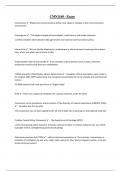CMN1160 - Exam
Introduction ✔️Media and communications policy must adapt to changes in the communications
environment
Convergence ✔️-The digital merging of technologies, media forms, and media industries
-conflicts between international trade agreements and national communications policy
Interactivity ✔️We are quickly adapting to a mediascape in which we have increasing choice about
how, when, and where we consume media
Trade between the US and Canada ✔️If no Canadian cultural policies were in place, American
productions would easily flood our marketplace
CUSMA (Canada, United States, Mexico Agreement) ✔️-Canadian cultural exemptions were made in
the original 1987 NAFTA agreement, but exceptions would allow the US to retaliate and seek financial
redress
-CUSMA extends free trade provisions to "digital trade"
WTO ✔️There are no general exemption for cultural industries under the WTO
Convention on the production and promotion of the diversity of cultural expressions (UNESCO, 2005)
✔️-Canadian was first to ratify
-this convention has not been signed by the US and to date has no bearing on international trade law
Creative Canada Policy Framework ✔️-The Department of Heritage (2017)
-series of proposed policy measures to bolster national creative or cultural industries (ex. tax credits,
copyright reform, strengthening public broadcasting)
Telecommunications Act (1993) ✔️-defines telecommunications as "the emission, transmission or
reception of intelligence by any wire, cable, radio, optical or other electromagnetic system, or by any
similar technical system"
,-until 1996, telecommunications and broadcasting treated as separate industries
Convergence Policy Statement (1996) ✔️-government intended to break down barriers between
telecommunications, broadcasting, and cable markets
-allowed telephone and cable companies to buy TV, radio, and newspaper companies
Federal government struck a panel to review the broadcasting and telecommunications acts in June
2018 ✔️-review panel will consider hot to "best support the creation, production and distribution of
Canadian content in both French and English - and focus on updating and modernizing the broadcasting
system"
-scheduled to report its finding in January 2020, with legislative changes to follow
Telecommunications - $50.3 billion industry with six subsectors: ✔️-local wireline telephone service
-long-distance wireline telephone service
-internet services
-data transmission
-private line
-wireless services
*five largest companies (Bell, Quebecor, Rogers, Shaw, Telus) generate 87% of revenues
Canadian Radio-television and telecommunications commission (CRTC) ✔️-enforces the
telecommunications act
-directed to interfere with market forces as little as possible
-four basic principles: transparency, fairness, predictability, and timeliness
-has refrained from regulation mobile, retail internet, international, satellite, and long-distance
telephone services
-intervenes in areas regarding tariffs and the licensing of International telecommunications services
*the telecommunications act stipulates that telecom companies must be Canadian-owned and
controlled
, Key policy issues in telecommunications: convergence; affordability and access; foreign investment ✔️-
Vertical integration between content and carriage raises issues such as ability of independently owned
TV networks to access distribution networks
- "Canadians pay some of the highest prices in the industrialized world for cellphone plans" (Harris,
2018)
- Increasing foreign ownership of Canadian telecommunications companies sometimes touted as away
to lower costs and increase access
- However, might be difficult to make foreign companies comply with Canadian regulations (ex. Netflix)
Broadcasting ✔️-Broadcasting is a $17.9-billion industry that includes radio and television, as well as
the distribution services of cable and satellite.
-Distribution (49% of revenues), television (41%), and radio (10%)
-Television viewing has largely migrated to the internet
Broadcast regulation and policy ✔️- Needed to manage and assign airwaves to radio, television,
emergency services, and the military
- Canadian mandate to serve national, cultural, and political goals
- Broadcasting is licensed and regulated by the CRTC; the CRTC can also establish new policy.
Broadcasting -continued ✔️- "Access to broadcasting"
* The inclusion of all Canadians in the content and production of programming• Conventional television
licensees are no longer required to air Canadian content during the daytime.
- Must carry at least 50% Canadian programming in the evening hours
- Other broadcast regulators
* Canadian Broadcast Standards Council (CBSC)
* Advertising Standards Canada (ASC)
Internet ✔️*One of the biggest issues in recent years is net neutrality
- Refers to internet service providers (ISPs) treating all content and applications equally, without
degrading or prioritizing service based on their source, ownership, or destination
- Throttling or traffic shaping: concern that ISPs might unfairly slow traffic from some sources or to some
users in order to discourage their use




